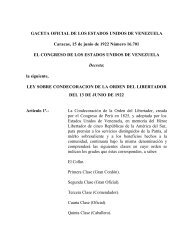Chapter 5 - WebRing
Chapter 5 - WebRing
Chapter 5 - WebRing
You also want an ePaper? Increase the reach of your titles
YUMPU automatically turns print PDFs into web optimized ePapers that Google loves.
CHAPTER 5. MAGNETIC SYSTEMS 241<br />
Problem 5.6. Thermodynamics of the Ising chain<br />
(a) What is the ground state of the Ising chain?<br />
(b) What is the entropy S in the limits T → 0 and T → ∞? The answers can be found without<br />
doing an explicit calculation.<br />
(c) Use (5.48) for the free energy F to verify the following results for the entropy S, the mean<br />
energy E, and the heat capacity C of the Ising chain:<br />
S = Nk ln(e 2βJ 2βJ<br />
+1)−<br />
1+e −2βJ<br />
<br />
, (5.49)<br />
E = −NJ tanhβJ, (5.50)<br />
C = Nk(βJ) 2 (sechβJ) 2 . (5.51)<br />
Verify that the results in (5.49)–(5.51) reduce to the appropriate behavior for low and high<br />
temperatures.<br />
(d) A plot of the T dependence of the heat capacity in the absence of a magnetic field is given in<br />
Figure 5.4. Explain why it has a maximum.<br />
5.5.2 Spin-spin correlation function<br />
We can gain further insight into the properties of the Ising model by calculating the spin-spin<br />
correlation function G(r) defined as<br />
G(r) = sksk+r −sk sk+r. (5.52)<br />
Because the average of sk is independent of the choice of the site k (for toroidal boundary conditions)<br />
and equals m = M/N, G(r) can be written as<br />
G(r) = sksk+r −m 2 . (5.53)<br />
The average is over all microstates. Because all lattice sites are equivalent, G(r) is independent of<br />
thechoiceofk anddependsonlyontheseparationr (foragivenT andH), wherer istheseparation<br />
between the two spins in units of the lattice constant. Note that G(r = 0) = m 2 −m 2 ∝ χ [see<br />
(5.17)].<br />
The spin-spin correlation function G(r) is a measure of the degree to which a spin at one<br />
site is correlated with a spin at another site. If the spins are not correlated, then G(r) = 0. At<br />
high temperatures the interaction between spins is unimportant, and hence the spins are randomly<br />
oriented in the absence of an external magnetic field. Thus in the limit kT ≫ J, we expect that<br />
G(r) → 0 for any r. For fixed T and H, we expect that, if spin k is up, then the two adjacent<br />
spins will have a greater probability of being up than down. For spins further away from spin k,<br />
we expect that the probability that spin k +r is up or correlated will decrease. Hence, we expect<br />
that G(r) → 0 as r → ∞.

















